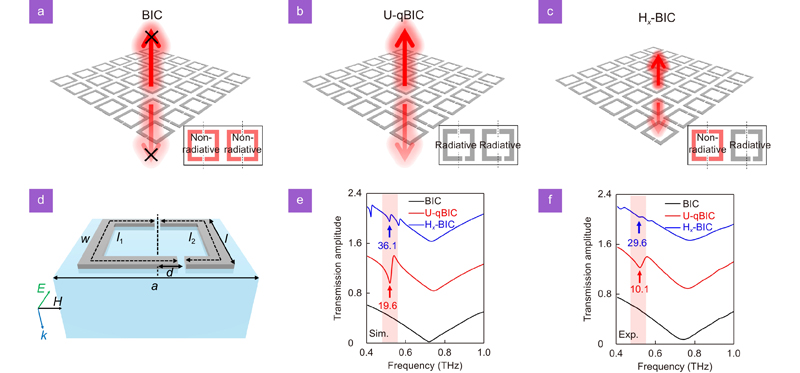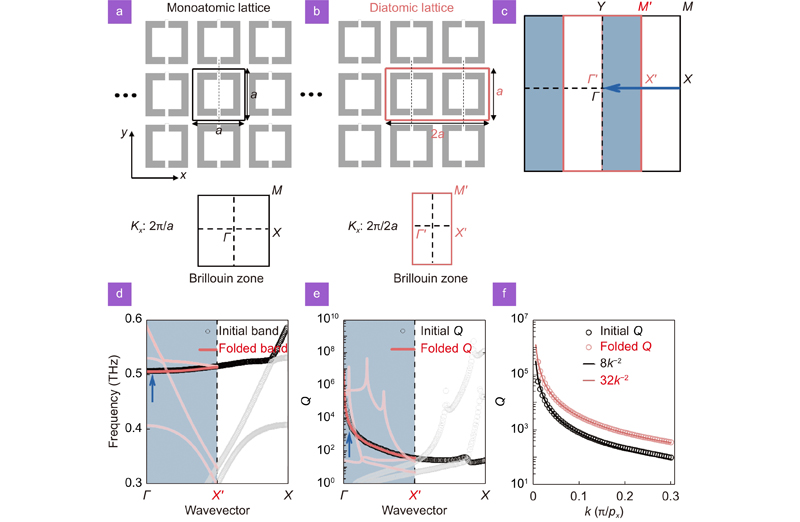Junxing Fan, Zuolong Li, Zhanqiang Xue, Hongyang Xing, Dan Lu, Guizhen Xu, Jianqiang Gu, Jiaguang Han, Longqing Cong. Hybrid bound states in the continuum in terahertz metasurfaces[J]. Opto-Electronic Science, 2023, 2(4): 230006
Search by keywords or author
- Opto-Electronic Science
- Vol. 2, Issue 4, 230006 (2023)

Fig. 1. Hybrid BIC lattices. (a –c ) Schematic diagram of a symmetry-protected BIC lattice without radiation channel (a), a uniform quasi-BIC lattice with radiation channel open by breaking symmetry of all the resonators (b), and a hybrid quasi-BIC lattice with C2 symmetry preserved in the neighboring resonators along x-axis in a supercell (c). (d ) A double gap split ring resonator as the unit cell of the metasurface. (e , f ) Simulated (e) and experimental (f) transmission amplitude spectra for the three-type lattices. The same asymmetry degree (α = 4.95%) was applied for U-qBIC and Hx-BIC metasurfaces.

Fig. 2. Interpretation of hybrid BIC from reciprocal space. (a , b ) Brillouin zones of monoatomic and diatomic supercells at α = 0 when the periods were chosen with a and 2a in the x direction. (c ) Illustration of Brillouin zones for monoatomic and diatomic supercells showing the band folding operation where X and M points in the BZ of a monoatomic supercell are folded to X′ and M′ points in the BZ of a diatomic supercell, and Г(Г′) point is fixed. (d ) Band diagrams of monoatomic (black circles) and diatomic (orange lines) supercells showing the folding behavior where all the modes of a monoatomic supercell in unshaded region are reflected into the shaded region representing modes of a diatomic supercell. (e ) Radiative quality factors of monoatomic and diatomic supercells. The same folding behavior of Q is inherited from the eigenmodes. (f ) Comparison of radiative Q versus k between monoatomic and diatomic supercells. Circles are simulated values and solid lines are fitting curves with Eq. (2) whose coefficient is 4-times larger in a diatomic supercell than that of a monoatomic supercell. Here, px is period of supercell along x direction. Perfect electric conductor (PEC) was used for DSRRs in simulations to calculate eigenvalues and quality factors.
Fig. 3. Experimental demonstration of the high-Q hybrid BIC. (a , b ) Microscopic images of U-qBIC and Hx-BIC metasurfaces. Supercells of U-qBIC and Hx-BIC metasurfaces are shown in the inset. Scale bar, 20 μm. (c ) Simulated transmission amplitude spectra of U-qBIC (left) and Hx-BIC (right) metasurfaces at an asymmetry degree of 2.97% with excitation electric field polarized along y-axis. Band diagrams of U-qBIC and Hx-BIC supercells are shown in the middle. (d ) Simulated radiative Q (circles) versus asymmetry degree (α) with inverse quadratic fitting curves (solid lines) of U-qBIC (black) and Hx-BIC (orange) supercells. Here, an additional constant of β is necessary to account for the nonuniform asymmetry in the hybrid lattice. (e ) Experimental transmission amplitude spectra of U-qBIC and Hx-BIC metasurfaces at an asymmetry degree of 7.42% with excitation electric field polarized along y-axis. The linewidth of Fano resonances is larger than that of simulations due to Ohmic loss in metallic resonators (aluminum) and finite number of supercells.
Fig. 4. Generalized high-order hybrid BICs. (a , b ) Microscopic images of Ht-BIC and Hq-BIC metasurfaces with three and one asymmetric resonators out of four in a 2×2 supercell, respectively, and the period is 2a along both x and y axes. Scale bar, 20 μm. (c ) Schematic diagram of band folding from U-qBIC lattice (black) to Ht-BIC/Hq-BIC (red) in the Brillouin zone. (d ) Simulated transmission amplitude spectra of the Ht-BIC (left) and Hq-BIC (right) metasurfaces at an asymmetry degree of 2.97%. The band structure of Ht-BIC/Hq-BIC is shown in the middle, and the modes at the Г point marked with different colored circles are folded from X (red), Y (orange), and M (blue) points in the Brillouin zone of U-qBIC lattice, respectively. The highlighted resonances show the original modes inherited from U-qBIC lattice. (e ) Experimental (orange) and simulated (black) transmission amplitude spectra of Ht-BIC and Hq-BIC metasurfaces at an asymmetry degree of 7.42%. The overall linewidth of Fano resonances is larger than that of simulations due to Ohmic loss in metallic resonators (aluminum) and finite number of supercells.
Fig. 5. Significant Q improvement in hybrid BIC supercells and robustness against fabrication imperfections. (a ) Evolution of radiative Q versus AD for U-qBIC, Ht-BIC, Hx-BIC, and Hq-BIC supercells. The overall quality factors are improved in hybrid supercells with a lower radiation density. (b ) Influences of fabrication imperfection on quality factors in the four scenarios. Imperfection is introduced by adjusting the sharp right-angle of square in the resonators to rounded angles indicated by radius r. Q and Q' indicate radiative quality factors for lattices with right-angle and rounded-angle resonators, respectively.

Set citation alerts for the article
Please enter your email address



